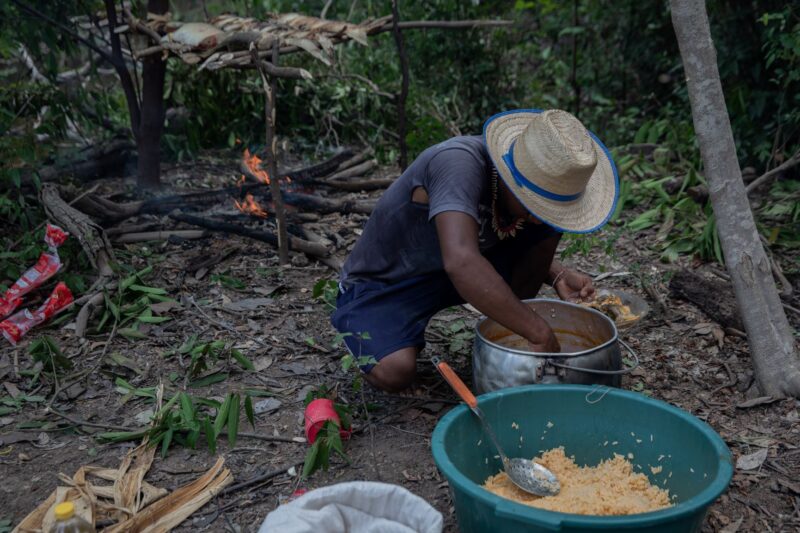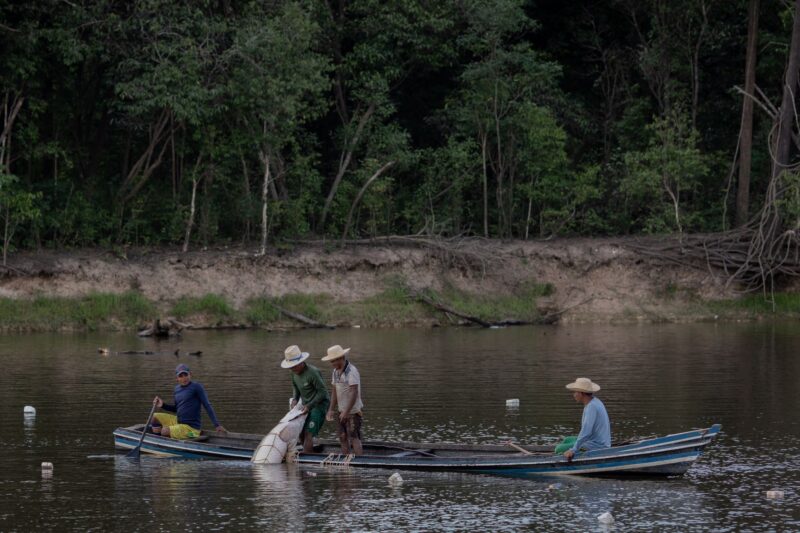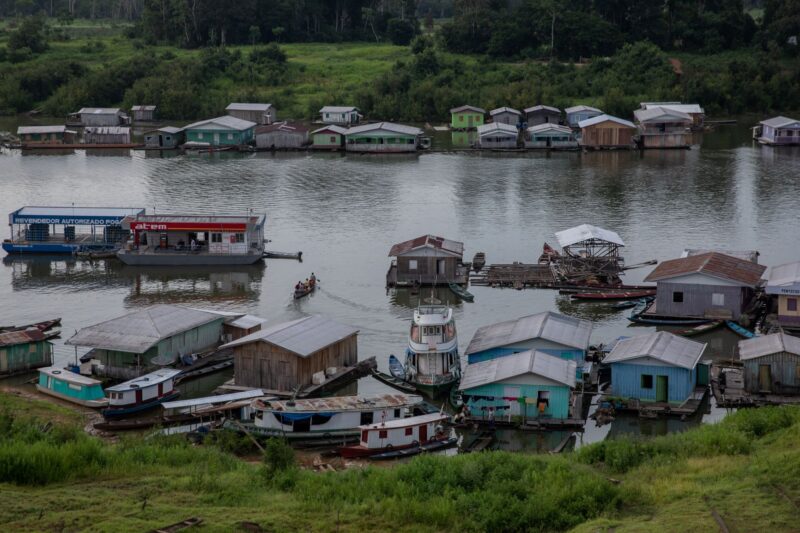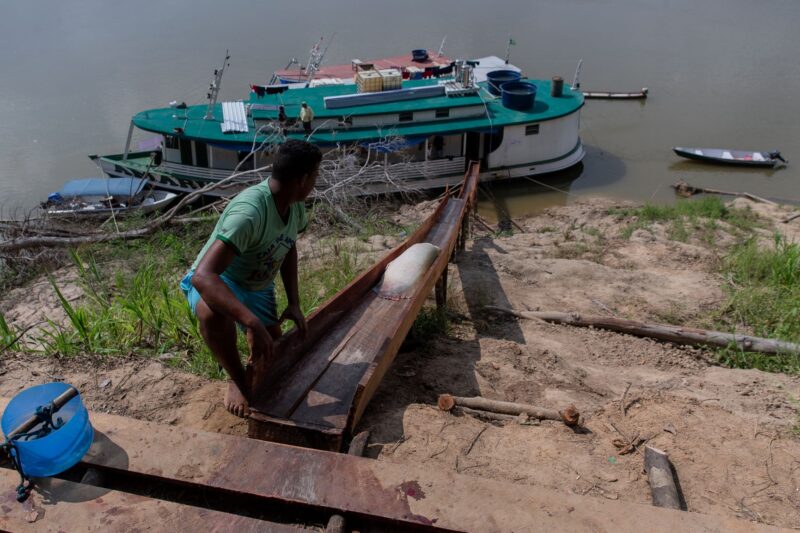Camped on the banks of the Xeruá river, a tributary of the Juruá river, members of the Deni group share multiple activities before embarking on the search for the mythical giant fish pirarucu (also known as arapaima).
Swift and good-natured, they fish arowanas, pacus, piranhas and peacock bass for their own dinner, set up hammocks under canvas tents, build a ladder to get down to the riverbank, adjust the gillnets, overhaul the rabetas (low-power boat engines) and reinforce the floater.
The Denis are one of the people of the Middle Juruá who have adopted in their own way a managed approach to fishing pirarucu, in a productive chain that comprises social organisation, control of their territory, rational use of natural resources and income generation.
Distant from the artisanal mining and deforestation fronts, this vast region connected by 650 kilometres of the winding Juruá river is staking its chances of surviving well, with the forest still in place, on the managed fishing of pirarucu as well as other productive chains. The scheme involves around 35,000 people spread over an area of 5 million hectares, according to an estimate of the Juruá Institute, a local conservation organisation.
The transformation began with the demarcation of the indigenous lands and the extractive reserves, ending the threat of expulsion of indigenous people from their homes and of labour relations akin to slavery. Another consequence was a decrease in predatory fishing done by large boats from Manaus.
Until quite recently the Denis were subject to constant harassment by the owners of rubber tree groves, rubber tappers, fishermen, loggers, and traders. Diseases brought by the white man led to successive tragedies. In the early 1990s, tuberculosis and measles almost wiped out the entire group.
The Denis’ situation only began to improve from 2003, with the demarcation of their 1.5 million hectare territory located between the rivers Juruá and Purus. Today their numbers are estimated at 2,000 people.
“Before the demarcation, there were no pirarucu or other fish left in any of the lakes, because the whites had taken over our river,” says the president of Aspodex (Association of the Deni People of Xeruã River), Pha’avi Hava Deni, 25. “After the demarcation we recovered the pirarucu and our game, because we practice conservation. There are areas where we don’t hunt or fish. That’s why we’re in a good place today.”
The management of pirarucu is also done by the river dwellers of the Juruá. In a situation similar to the Denis, they used to work in conditions akin to slavery for the owners of rubber groves and logging concerns, who would grab lands illegally or gain possession of enormous swathes of public lands for next to nothing.

Residents of extractivist reserves have greater access to public services such as healthcare, schools and electricity, as well as durable goods (fridges, motor boats) than do the river dwellers living outside the conservation units (All photos: Eduardo Anizelli/Folhapress)
The rise of the Amazonian rubber tappers movement, led by Chico Mendes (1944-1988) and others in the 1980s, led to the creation of extractive reserves. There are two in the region: the federal Resex (Extractive Reserve) of the Middle Juruá, created in 1997, and the RDS (Sustainable Development Reserve) of Uacari, created by the state of Amazonas in 2005.
Each activity takes place at a certain time of year. Pirarucu is fished during the period of low water around September, and the activity involves some complex logistics.
With their numbers concentrated in lakes, the pirarucu, once captured, must be taken to a large boat on the river Juruá that is loaded with ice. From there the fish goes to Carauari, then on to Manacapuru and Manaus. This, the state capital, is 1,540 kilometres away. Part of the production is now sent on to the great cities of Brazil, including São Paulo.
The Denis started setting up the project in 2009, with support from Opan (Operation Native Amazonia). One of the first steps was to count the number of pirarucus living in their territory. This process is repeated yearly.
Created by river dwellers from the region of Mamirauá, in Tefé (Amazonas state), the technique consists of counting the fish when they come to the surface, which they do as their breathing is both branchial and aerial. They are counted in stages across the entire lake in cycles of 20 minutes –the longest time they can last before coming up for air.
The person doing the counting must differentiate the adult pirarucu from the young ones (known as bodecos), that can reach up to 1.5 metres in length. Catching young ones is forbidden. The pirarucu is the largest freshwater fish with scales in the world; it can reach 200 kilos in weight and three metres in length.
At the most recent counting, last year, 3,300 pirarucus were found in the Denis’ territory, in lakes divided into the three categories included in the protocol: for community use, for managed pirarucu fishing, and lakes where no fishing is allowed.
In 2021 the Denis fished one hundred pirarucus in a little over two days. The number needs to be authorised by Ibama, which allows fishing of up to 30% of the stock in the managed lakes. Outside these, fishing is forbidden.
Climate Home News accompanied the fishing expedition in 2021, in which four of the five Deni villages in the region of the Juruá river took part. Due to the great distances, the villagers all came together in a big camp set up between the lakes and the mouth of the Xeruã, where a boat with ice awaits the arrival of the catch.
The same low water that leads the pirarucu to concentrate in the lakes hinders navigation. Over the period we covered, the so-called channel (connecting a lake to a river) to reach the Abelha Velha lake held only a few centimetres of water. The trip there took an hour and was relatively easy, except for the many tucunarés, peacock bass, who would jump inside the boat.

While only 5% of the residents of extractivist reserves want to migrate to cities, compared to 58% among those living in non-protected areas
The problem was returning with our canoes filled to the brim with gigantic fish, each one weighing on average 61 kg. But the biggest fish caught in 2021 weighed 110 kg and was 2.24 metres long.
The Denis had to get out of the canoe and pull it over the almost dry riverbed, running the risk of treading on stingrays. Some of the return trips took four hours and only arrived after nightfall.
A few kilometres from there, in the RDS Uacari, the logistics were easier. The managed fishing lake was closer to the river. A quad bike dragged the fish to the riverbank. A wooden slide was built to take the fish down to the boat, where the pirarucus were gutted and stored on ice. They hurtled down the slide with such force that one of them broke the sides of the slide and ended up in the boat’s engine compartment.
The entire catch from the managed areas of the Middle Juruá is bought by Asproc (Association of Rural Producers of Carauari). Founded in 1991 by river dwellers, with strong support from the Catholic Church, the organisation has been largely responsible for the virtuous cycle in the region.
The main goal when it was founded was to overcome decades of the system known as aviamento, in which rubber tappers fell into constant debt to their bosses when they exchanged rubber for basic goods, that were sold to them at extortionate prices. They were also fighting for the creation of extractive reserves so as to overcome the river dwellers’ uncertain situation regarding ownership of the land they lived on.
One of the measures taken by Asproc was the creation of a network of so-called “canteens”, or trading posts. In RDS Uacari, for instance, a pair of Havaianas flip-flops costs R$ 14.50 ($2.79), similar to the price in big cities.
The fair price principle also covers the purchase of the fish catch. In the case of pirarucus, Asproc pays R$ 7 per kilo ($1.34), the highest price in Amazonas. On the banks of the Purus, for example, the fish is usually sold for only R$ 5.5 ($1.05) per kilo.
Besides bringing in income, managed pirarucu fishing helps recover the fish population, ravaged by ungoverned fishing. Over 11 years of managed fishing, pirarucu stocks have risen 425% in the area, according to the Juruá Institute.
One of the most important leaders in the region, the chief of the Middle Juruá Resex, Manoel Cunha, 58, says that managed fishing of pirarucu has strengthened community work and simultaneously improved the river dwellers’ income.
“Managed fishing is something that can only be done collectively,” says Cunha, who is in charge of an area covering 187 thousand hectares and inhabited by 524 families, including his own. He says 90% of the people living in the area take part in the controlled production.
“Managed fishing brings about group organization. You attract people by their pockets, either from a negative or a positive viewpoint. When you cross a red light and are slapped with a fine, that is negative mobilisation. Pirarucu mobilises us positively, because you’re making an effort to organise your community to make more money.”

The city of Carauari, in Amazonas state
In the case of the Denis, the money is not shared among the families but deposited in the account of the association, that uses part of the proceeds to finance the management and saves another part.
“Managed fishing is a major help in strengthening the Deni people,” says Leonardo Kurihara, Opan’s project coordinator. “It ensures celebration, strength, recognition of demarcated lands. The money is set aside to bolster their organisation.”
The positive effects on the conservation units were measured in research published in October in the academic journal PNAS. The study compares the social-economic conditions of one hundred communities spread over 2,000 kilometres along the Juruá river.
According to the report, the residents of extractive reserves have better access to public services such as healthcare, schools and electricity, and also to durable goods (fridges, motorboats) than the river dwellers living outside the conservation units.
The net result is that while only 5% of the residents of extractive reserves wish to migrate to cities, this number rises to 58% among those living in non-protected areas.
“The Middle Juruá region has been gaining attention due to the strong action of local associations and their partners, that have been managing their natural resources efficiently,” says biologist João Campos Silva, lead author of the report and president of the Juruá Institute.
“The conservation units and indigenous lands mobilise many important factors: strong leaders and associations and multiple partners, be they NGOs, companies or town administrations,” he says.
At the start of the Jair Bolsonaro administration, the region suffered a hit because the Amazon Fund, made up mainly of resources donated by Norway, was frozen. Before that, projects such as the Asproc boat that transports the pirarucu according to sanitary standards, were paid for by the fund. There are approximately R$2.9 billion ($0.6bn) in the foundation’s account that can’t be used.
“It was awful, it made no sense. We had a project that had already received final approval after a public bidding process and that was supposed to consolidate this experiment we are undertaking,” says Adevaldo Dias, 48, advisor to Asproc and president of the Chico Mendes Memorial, in Manaus.
“We were going to build a fruit pulp factory, processing the forest fruits, and a fish distribution unit in Manaus. At the moment it is very difficult for the fish to reach Manaus; sometimes we can’t find any place to store the catch, even if we pay rent. There are times when everywhere is already taken,” he concludes.

A man sends a pirarucu off to be gutted in a boat belonging to the Xibauazinho community, on the banks of river Juruá
Without the money from the Amazon Fund, Asproc used its working capital to set up a meatpacking unit in Carauari last September. Until then, all the pirarucus had to be taken to Manacapuru. Nowadays, part of the production leaves the unit already packed and ready for consumption.
The association also has various supporters for specific projects, including USAID (the USA official aid organization), Natura, Coca-Cola, Petrobras, Opan, and FAS (Sustainable Amazon Foundation), among others.
“The solution for the problems we hear about on the news is in the conservation units, for the forest, the environment and the families,” concludes the president of Asproc, Manuel Siqueira, 45. “What is true here is the opposite of what is said: conservation units mean development.”
This reporting is part of The Amazon under Bolsonaro, a collaboration between Folha De Sao Paulo and Climate Home News. The text was translated from Portuguese by Clara Allain. All photos by Eduardo Anizelli. Cover image: Fishing for pirarucu.